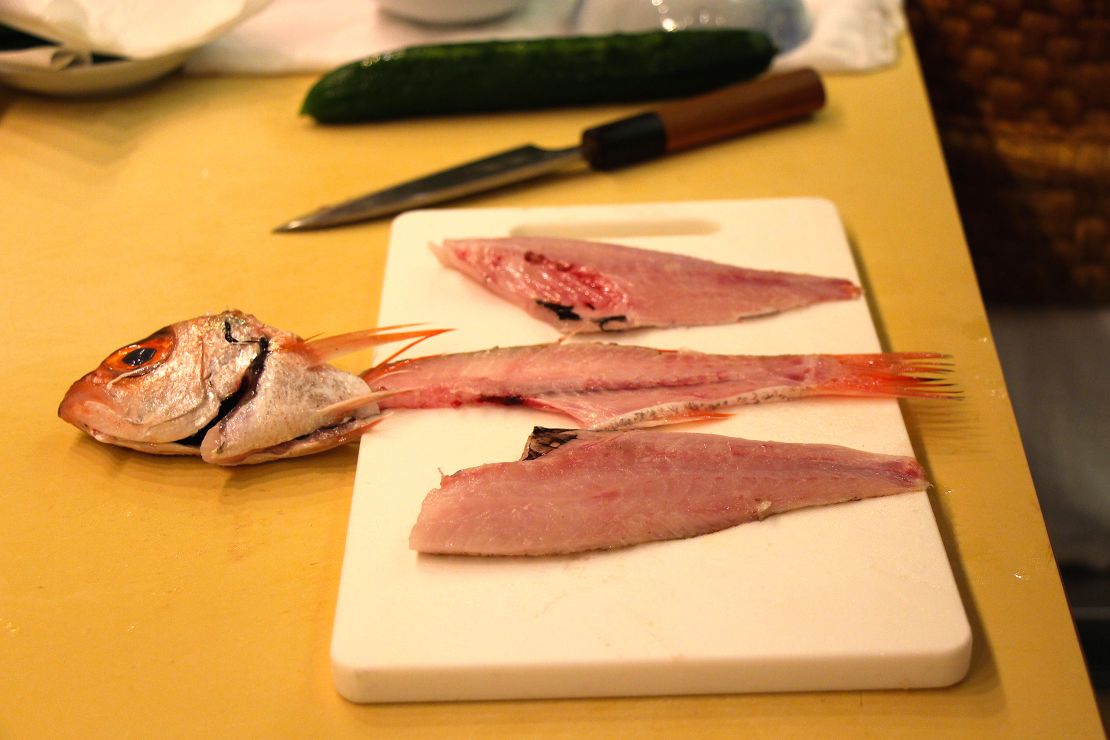CNN’s On the Road series often carries sponsorship originating from the countries we profile. However CNN retains full editorial control over all of its reports. Read the policy.
Story highlights
It's difficult to make good nigiri zushi, the most famous form of sushi, without years of practice
Maki-rolls are easy to make at home
The best sushi rice is a mix of harder mountain rice and softer varieties
Nigiri zushi, the most famous representation of sushi, appears to be just a bundle of rice topped with a piece of raw fish.
You don’t even have to cook it. Sounds like the easiest dish ever to make? Not exactly.
“We spent the first 25 minutes just talking about which fish we should buy and can be made into sushi from the market,” says Evelyn Teploff-Mugii, one of three American women who founded the Kanazawa-based company, The Art of Travel.
Teploff-Mugii is recalling a conversation she had with Kanazawa sushi chef Masaki Teranishi.
Teploff-Mugii’s company focuses on offering private tours around Japan that include shopping at a fish market and learning how to make sushi in a private kitchen.
“Every part of sushi-making is very deep in context and an art for sushi chefs,” she says.
Making sushi is no easy chore. Donning a full Shinto sushi outfit when at work, chef Teranishi has been a sushi chef for 30 years. He’s the head chef of a family-run, 70-year-old sushi business. He’s also the region’s only certified chef of houchoushi, an ancient fish-cutting style and ceremony that highlights the knife skills of a chef.
CNNGo in Japan: Wagyu, ramen, sake
How to pick the right fish
“Determining which fish to buy is totally seasonal and regional,” says Teranishi.
He isn’t just talking about the four seasons, but the many mini-seasons in between. To complicate things further, names of the same fish change depending on seasons, since fish flavors can change accordingly.
“For example, snapper is called ‘tai’ in winter but ‘sakura dai’ in spring and summer,” says Teranishi. “Tai is more fatty and oily than sakura dai as fish tend to store more fats in winter.”
Yellowtail is usually called “buri,” but it’s “buri-okoshi” during rough weather in December.
“We believe that during a storm, buri is awakened and swims to the surface,” he explains. “Buri-okoshi is more alive.”
As a region, Kanazawa is known for squid, flounder and yellowtail.
To pick a good fish, lift the gill using a finger. Pink and red indicate fresh catches.
“You want to make sure the fish has firm flesh,” says Teranishi. “Mushy texture suggests the meat is already breaking down.” If you aren’t allowed to touch a fish, look for a fish with a swollen belly and clear eyes, and avoid fish with liquid oozing out.
Gutting and cutting

Fish should be gutted and washed as soon as it’s brought back to the kitchen and is best consumed the same day.
The most common ways to cut a fish are san-mai-oroshi (three-piece cut) and go-mai-oroshi (five-piece cut).
Both methods include slicing the middle section with the bone out, and separating it from the two side flaps.
Go-mai-oroshi cuts the two fillets further into four thinner slices. Twisser tools are used to remove small bones on fillets before they’re cut into small pieces for sushi.
“Fish meat is very delicate,” says Teranishi. “Every time you touch a fish, you’re damaging it.” Less adventurous cooks may consider already-cut fillets at the market.
Ultimate guide to Japan’s marbled and flavorful Wagyu beef
Making the rice
Sushi rice’s glamor is often stolen by the fish above it, yet the rice is “so, so important,” says Teranishi. Generally, the harder and older the rice, the better for sushi making.
“Mountain fields produce the best sushi rice,” says Teranishi. “But to produce the best texture, we often mix the harder mountain rice with softer rice.
“Sasanishiki rice from Sendai is a famous one we use in the mix.”
Once the rice is cooked, quickly cool it off using a fan while slowly mixing the seasoning – vinegar, salt, sugar and Japanese rice wine – into the rice.
The rice should be gently slapped into shape using two fingers and a cupped palm.
“Don’t squeeze,” says Teranishi. “The gathering of the rice should be done by slapping using strength from one’s wrist, so the rice sticks together without pushing out the air between the rice.”
Making maki-rolls
Homemade nigiri zushi isn’t impossible to make, but mastering the skills takes time. Teranishi suggests making maki-rolls for more predictable results.
“I’m a firm believer that everyone can make good maki-rolls at home,” says Teranishi. “They’re an important part of sushi and are fun to make with endless combinations.”
For maki-roll, instead of cupping rice into a bundle and slicing fish into small pieces, the rice is gently spread on a piece of dried sea kelp. Ingredients are cut into sticks and placed in the center. Then, everything is rolled into a tube-shape using a rolling mat.
As for ingredients, it’s usually a combination of fish and vegetables, but there are no strict rules for what can go in the roll.
“Teranishi once prepared a roll with mayonnaise for a Swedish family with small kids so they’d enjoy it more,” says Teploff-Mugii.
“As he said, just go ahead and stuff it.”
Kanazawa Sushi Supreme Tour is conducted by The Art of Travel.
Kanazawa Tamazushi Souhonten (Flagship), 2-21-19, Katamachi, Kanazawa, Ishikawa; +81 76-221-2644
Kanazawa Tamazushi, Kanazawa New Grand Hotel B1F, 4-1, Minami-cho, Kanazawa, Ishikawa; +81 76-233-0911
Kanazawa Tamazushi, Korinbo Daiwa, 1-1-1, Korinbo, Kanazawa, Ishikawa; +81 76-220-1346
Kanazawa Tamazushi Keibajyonaiten, A 549-1, Hattamachi, Kanazawa, Ishikawa; +81 76-258-5568
















